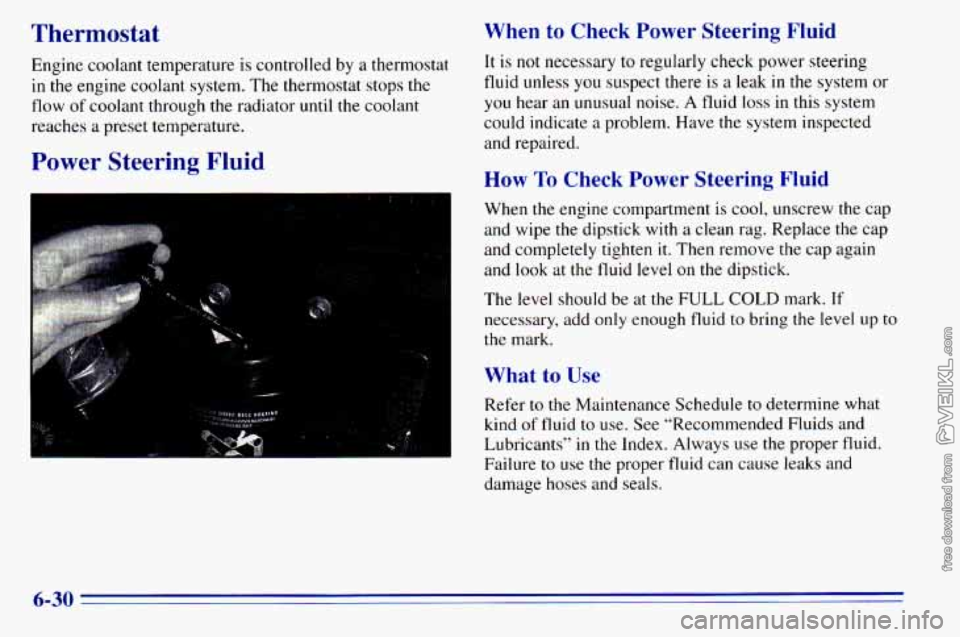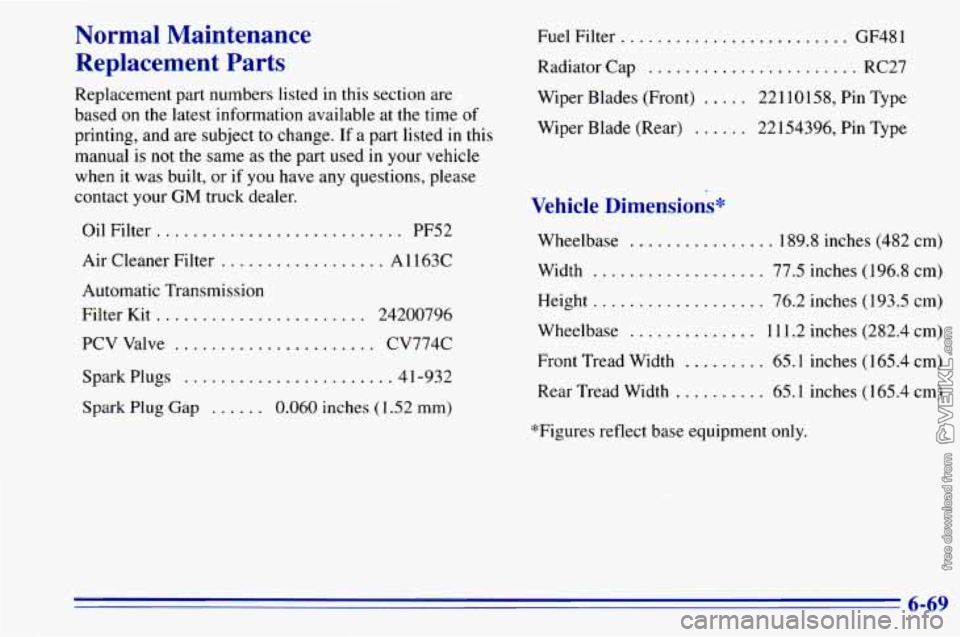Page 257 of 372
NOTICE:
If you use an improper coolant mix, your engine
could overheat and be badly damaged. The repair
cost wouldn’t be covered by your warranty. Too
much water in the mix can freeze and crackthe
engine, radiator, heater core and other parts.
If you have to add coolant more than four times a year,
have your dealer check your cooling system.
I NOTICE: I
If you use the proper coolant, you don’t have to
add extra inhibitors or additives which claim
to
improve the system. These can be harmful.
Checking Coolant
When your engine is cold, the coolant level should be at
ADD, or a little higher. When your engine is warm, the
level should be up to
FULL HOT, or a little higher.
6-27
Page 258 of 372
Adding Coolant If ,you need more coolant, add the proper mix
at the
Add coolant mix at the recovery tank, but be,careful not
to spill it.
' A CAUTION:
Turnj J the radiator pressure cap when the
engine.and radiator are hot can allow steam and
scalding liquids to blow out and burn you badly.
With the'coolant recovery tank, you will almost
never have
to add coolant at the radiator.
Never turn the radiator pressure cap
-- even a
1. little -- when,the engine and radiator are hot. I
You can be burned if you spill coolant on hot
engine parts. Coolant contains ethylene glycol,
.
and it will burn if the engine parts are hot
enough. Don't spill coolant on
a hot engine.
6-28
Page 259 of 372
Radiator Pressure Cap
NOTICE:
Your radiator cap is a 15 psi (105 kPa)
pressure-type cap and must be tightly installed to
prevent coolant loss and possible engine damage
from overheating. Be sure the arrows on the cap
line
up with the overflow tube on the radiator
filler neck.
When you replace your radiator pressure cap, a GM cap
is recommended. See “Normal Maintenance
Replacement Parts” in the Index.
6-29
Page 260 of 372

Thermostat When to Check Power Steering Fluid
Engine coolant temperature is controlled by a thermostat It is not necessary to reg,ularlY check Power steering
in the engine coolant system. The thermostat stops the fluid unless you suspect there is a leak in the system or
flow
of coolant through the radiator until the coolant you
hear an unusual noise. A fluid loss in this system
reaches a preset temperature. could indicate
a problem. Have the system inspected
and remired.
Power Steering Fluid
I
How To Check Power Steering Fluid
When the engine compartment is cool, unscrew the cap
and wipe
the dipstick with a clean rag. Replace the cap
and completely tighten
it. Then remove the cap again
and look at the fluid level
on the dipstick.
The level should be at the
FULL COLD mark. If
necessary, add only enough fluid to bring the level up to
the mark.
What to Use
Refer to the Maintenance Schedule to determine what
kind
of fluid to use. See “Recommended Fluids and
Lubricants’’
in the Index. Always use the proper fluid.
Failure to use the proper fluid can cause leaks and
damage hoses and seals.
6-30
Page 261 of 372
Windshield Washer Fluid
What to Use
When you need windshield washer fluid, be sure to read
the manufacturer’s instructions before use.
If you will be
operating your vehicle
in an area where the temperature
may fall below freezing, use
a fluid that has sufficient
protection against freezing.
Adding Washer Fluid
Open the cap labeled
WASHER
FLUID ONLY.
Add washer fluid until the
tank is
full.
NOTICE:
When using concentrated washer fluid,
follow the manufacturer’s instructions for
adding water.
Don’t mix water with ready-to-use washer
fluid. Water can cause the solution to freeze and damage your washer fluid tank and other parts
of the washer system. Also,
water doesn’t clean
as well as washer fluid.
three-quarters full when it’s very cold. This
allows for expansion, which could damage
the tank if it is completely full.
windshield washer. It can damage your
washer system and paint.
Fill your washer fluid tank only
Don’t use radiator antifreeze in your
6-31
Page 299 of 372

Normal Maintenance Replacement
Parts
Replacement part numbers listed in this section are
based on the latest information available at the time of
printing, and are subject to change.
If a part listed in this
manual is
not the same as the part used in your vehicle
when it was built, or
if you have any questions, please
contact your
GM truck dealer.
Oil Filter..
......................... PF52
Air Cleaner Filter
.................. A 1 163C
Automatic Transmission
Filter Kit
............ ... 24200796
PCV Valve
...................... CV774C
Spark Plugs
....................... 41-932
Spark
Plug Gap ...... 0.060 inches (1.52 mm) Fuel
Filter
...
Radiator Cap .......
Wiper Blades (Front) .
Wiper Blade (Rear) . .
. . GF481
............ RC27
. . 22110158, Pin Type
. . 22154396, Pin Type
Vehicle Dimensions*
Wheelbase .............. 189.8 inches (482 cm)
Width
................... 77.5 inches (1 96.8 cm)
Height.
.................. 76.2 inches (193.5 cm)
Wheelbase
.............. 11 1.2 inches (282.4 cm)
Front Tread Width
......... 65.1 inches (165.4 cm)
Rear Tread Width
........ 65.1 inches (1 65.4 cm)
*Figures reflect base equipment only.
6-69
Page 328 of 372
100,000 Miles (1 66 000 km)
0 Drain, flush and refill cooling system
(or every
60 months since last service,
whichever occurs first). See “Engine
Coolant”
in the Index for what to use.
Inspect hoses. Clean radiator, condenser,
pressure cap and neck. Pressure test
cooling system and pressure cap.
An Emission Control Service.
0 Inspect spark plug wires.
Cl Replace spark plugs.
An Emission Control Service.
0 Inspect Positive Crankcase Ventilation
(Pcv) valve.
An Emission Control Service.
An Emission Control Service.
I DATE SERVICED BY ACTUAL MILEAGE
Short
TripKity Maintenance Schedule
99,000 Miles (165 000 km)
0 Change engine oil and filter (or every
3 months, whichever occurs first).
An Emission Control Service.
0 Lubricate chassis components; see
footnote
# (or every 3 months, whichever
occurs first).
0 Check readfront axle fluid level and add
fluid as needed. Check constant velocity
joints and axle seals
for leaking. **
DATE
SERVICED BY: ACTUAL MILEAGE
7-28
Page 340 of 372
Long Trip/Highway M
100,000 Miles (166 000 km)
0 Drain, flush and refill cooling system
(or every
60 months since last service,
whichever occurs first). See “Engine
Coolant”
in the Index for what to use.
Inspect hoses. Clean radiator, condenser,
pressure cap and neck. Pressure test
the cooling system and pressure cap.
An Emission Control Service. 3-
0 Inspect spark plug wires.
An Emission Control Service.
0 Replace spark plugs.
0 Inspect Positive Crankcase Ventilation
An Emission Control Service.
(PCV) valve.
An Emission Control Service.
DATE
SERVICED BY: ACTUAL MILEAGE
7-40